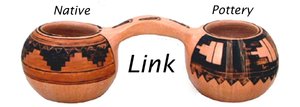
SAN CARLOS APACHE, Burden Basket. 14" wide #B480
Basket, Burden style, with hide dangles and metal cones.
Traditional design from San Carlos Apache tribe, woven by Mary Jane Dudley.
13" deep x 14" wide at top,
3 3/4" wide at base.
25" long hide dangles
Almost vintage, ca. late 20th century. Acquired in 2001.
US$1450
Free Shipping
within the 48 mainland United States




Additional Info
For years, a "burden basket" was just used for carrying things like food and wood. With the basket slung on the wearer's back and secured by a strap across the forehead, and hide strips bearing metal jingles, managing a burden was both easier to carry and protected from hungry critters. Such baskets were functional, but often were decorated as works of art, perhaps to "lighten" the load. Their individual touches and accents enhanced their attractiveness to collectors both within and outside tribal cultures. Apache burden basket weaving faded in popularity during the during the Great Depression, when affordable commercial containers became easier to acquire and Apache children were removed from opportunities to learn how to weave baskets.
In recent years, Native American basketweaving has had a re-surgency. Mary Jane Dudley of the San Carlos Apache band has benefitted from the market for work by excellent artisans. Mary Jane Dudley created her first basket at the tender age of 13 under the tutelage of her mother, Evelyn Henry, who in turn had learned from Mary Jane's grandmother, Cecilia Henry.
Burden baskets also play a major role in Apache culture. They are worn ceremonially by young girls passing into the age of womanhood.
A great amount of time, skill and patience goes into the process of harvesting cottonwood branches and collecting willow strips and devil's claw to weave into the design. All these components must be "cured" to become pliable enough to weave. This time-consuming and painstaking process is thus handed down through generations. It is deeply woven into San Carlos Apache culture.
For the artist, no price is great enough to fully compensate for the time and tradition that goes into a basket. Fortunately, it is also a labor of love.
